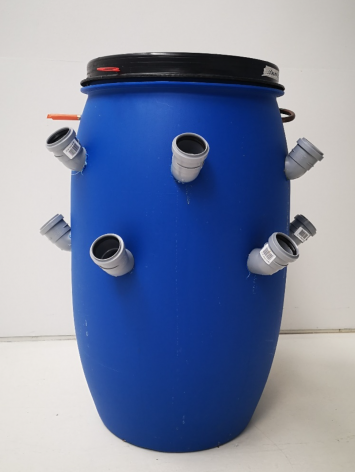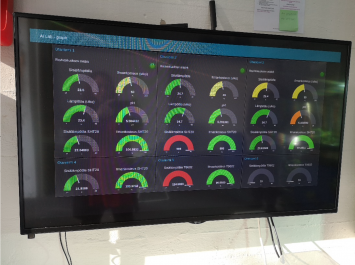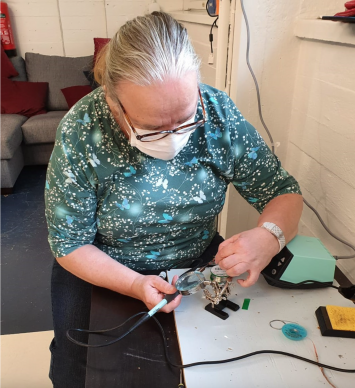How to attract new target groups to address the SDG objectives: The case of an intelligent aeroponic community garden
Link to the JSE General Issue May 2022 Table of Contents
Article PDF
Abstract: To successfully implement the UN’s Sustainable Development Goals (SDGs), we must encourage all citizens to work together to enable a good life not only for us now but future generations too. In this article, we present an experiment carried out in autumn 2020 on a smart aeroponic garden. The goal of the experiment was to learn more about aeroponic cultivation and IoT technology and to acquire the know-how that would enable the participants to influence the environmental burden of food production. Our experiment showed that technology could also be used to introduce sustainable development themes to reach those target groups whose attention could not be attracted through other methods.
Keywords: sustainable development, aeroponics, internet-of-things, community garden, sustainability education, vocational education, liberal education
Experiment background and objectives
Successful implementation of the UN’s Sustainable Development Goals (SDGs) requires new approaches and solutions, as we cannot solve the challenges by “old” means alone. The 2030 Agenda stresses the importance of SDG implementation and calls for multidimensional cooperation between businesses, organizations, and citizens. Therefore, one of the challenges is to encourage all citizens to work together to enable a good life both for us and for future generations.
Agriculture and food production account for about one-third of the world’s greenhouse gas emissions. Growing food where it is consumed reduces the carbon footprint of the food chain and the burden on the environment. Maintaining agricultural know-how is an important aspect of a nation’s food security. A lack of expertise, access to farmland, sufficient time, and financial resources required for farming limit the ability of ordinary citizens to produce their own food. Much of the world’s arable land is already in use. The lack of space, combined with a scarcity of water, necessitates new solutions to meet the food needs of the growing population. To provide enough food for everyone on earth, we need to be able to produce twice as much food in 2050 as we do now.
Omnia is a multidisciplinary education provider committed to achieving the UN’s SDGs by 2025. In a sustainable society, everyone has an equal opportunity to explore new technologies and acquire sufficient skills required to manage their everyday life and participate in society. At Omnia, the unit helping to resolve these particular challenges is the Omnia AI Lab. It is a unit that innovates and implements experiments to promote digital equality among citizens, students, and the Omnia community. Over the course of our experiments, we noticed that improving people’s technological prowess feeds and maintains the desire, enthusiasm, and willingness to active participation. It also increases the sense of meaning in one’s life.
In this paper, we present an experiment carried out in autumn 2020 on a smart aeroponic community garden as a learning environment. The goal of the experiment was for participants to learn more about aeroponic cultivation and IoT technology and to acquire the know-how to influence the environmental burden of food production. Aeroponic farming does not require arable land and only consumes a fraction of the water required in conventional farming. The aim of the experiment was to construct and test a prototype of a smart aeroponic cultivation unit that is cost-effective and functional enough to enable every citizen to produce their food. The communality typical for the community gardens has also been found to alleviate loneliness and bring many health benefits.
Experts from Omnia AI Lab built the first test garden, and the experiment initiated the pilot phase after the first tests (Image 1).
Aeroponic cultivation unit prototype
The objective was to build the aeroponic cultivation units using cheap, easily accessible supplies and tools utilizing—when possible—recycled material. Initially, the cultivation unit was based on a 220-liter barrel made of food-grade plastic and sewage pipe fittings. Later, a smaller 120-liter barrel was also tested in the garden. The holes for the pipe fittings were drilled into the barrel with a hole saw. The lower holes were positioned so as to leave sufficient space at the bottom of the barrel for the nutrient broth (Image 2).
A small submersible garden pump installed inside the barrel was used to spray the nutrient broth inside the barrel through a number of small rotating sprinkler-type nozzles (Image 3). One nozzle was used in the initial phase, but the number of nozzles was later increased due to their tendency to fail. This prevents the roots of the plants from drying out in case of nozzle failure. The nozzles were suspended on a copper pipe attached to the barrel cover. The copper pipes used were destined for recycling after being used in the building services engineering courses. Copper-based material was chosen to prevent harmful compounds from dissolving into the nutrient broth.
Community garden technology
Growing conditions in the cultivation units were measured by sensors attached to the units. Sensor data was processed locally on an ESP8266 microcontroller that used an MQTT protocol to wirelessly transmit the measurement results to the garden’s local server running on a Raspberry Pi 3b computer. The Raspberry Pi was tasked with forwarding the measurement results to the background system built on the Google Cloud Platform. The background system used was the open-source Node-Red platform. In Node-Red, data from the cultivation units were stored in a MySQL database and used to create a graphical dashboard view from which it was easy for the gardeners to monitor the growing conditions. The cloud service-based Node-Red also served as a link between the garden and the Telegram instant messaging application installed on the gardeners’ mobile phones. The system, for example, alerted the gardeners if the measured growing conditions exceeded the defined limits and automatically sent an up-to-date photograph of the garden upon request by the Telegram user (Figure 1).
At the start of the experiment, the aim was to measure the following growth conditions for each cultivation unit:
External temperature and humidity
Light intensity
Internal temperature
pH and electrical conductivity of the nutrient broth
Water level
Measuring the extra-unit variables proved to be straightforward, and the selected sensors were found to be practical. External temperature and humidity were measured with a DHT11 sensor and the light intensity was measured with an LDR resistor.
Measuring the variables inside the cultivation unit proved very demanding. The pH sensor we used was an analogue pH sensor by DFRobot. After the initial calibration, the results from the sensor were within the right range but very quickly the sensor measurements became unreliable. A reliable measurement of pH could not be established during the pilot project. It remained unclear, for example, whether the sensor was suitable for continuous pH measurement or only for occasional sampling. The electrical conductivity was measured using a DFRobot EC sensor, but reliable measurements could not be achieved during the pilot project. The nutrient broth temperature was measured with waterproof DS18b20 sensors. These sensors proved to be reliable under the very humid growth conditions inside the barrel that quickly caused oxidation of the other electrical devices tested.
In order to determine the operation of the pump and the nozzles, SHT20 sensors were tested to measure the humidity inside the cultivation unit. The lifetime of the sensors in the humid growth conditions proved completely inadequate with the sensors oxidizing so much that they became inoperable in about a week.
Starting the community garden
The participants in the experiment were recruited through the liberal adult education platform. The experiment was conducted in the form of a free-of-charge course open to everyone under the name “Grow aeroponic vegetables with the help of artificial intelligence.”
There were 15 participants accepted to the course that was advertised as an opportunity to participate in piloting the world’s first smart aeroponic community garden (Image 5). The course lasted a total of 12 weeks. The participants were promised the opportunity to grow tomatoes, chili, basil, and lettuce. To this end, we had the seeds and supplies ready at no extra charge. In addition to the above plants, the participants could bring any of their own vegetable seeds to grow in the garden if they liked. No prior preparations were required from the participants. They were only requested to bring a smartphone with them.
The content of the experiment was intended to meet the wishes of the participants, so the content was not planned in detail in advance. The participants were requested to consider what they wanted from the course before the first meeting: did they want to focus more on aeroponic cultivation or IoT technology? The participants seemed interested in all kinds of topics related to new technologies.
At the first meeting, a representative of the environmental organization Dodo gave a presentation on traditional urban gardens and community gardens. Aeroponic cultivation technology is such a new thing that we could not find any expert familiar with it. Hydroponic cultivation comes close to aeroponic cultivation so, at the first two meetings, we had an expert in commercial hydroponic cultivation explain the technology used in their field.
Participant enthusiasm expands the garden
Discussions during the first meeting revealed that the participants were interested in building themselves an aeroponic cultivation unit of their own after the experiment. Thus, we organized an extra meeting during which the participants built additional cultivation units in the garden with the help of Omnia’s vocational education students. The participants were taught the skills needed to build a cultivation unit, including how to use a cordless drill and a hole saw and to bend pipes. The joint effort produced more cultivation units, with the growing capacity of the garden more than doubling (Image 6).
The garden had a ceramic metal halide lighting fixture, which was a good choice in terms of price and lighting power. As the size of the garden grew, it proved challenging to provide sufficient lighting for the extra cultivation unit locations. The participants first tried to solve the problem by reorganizing the location of the units, but eventually, we ended up acquiring a second lighting fixture.
The gardeners were also interested in participating in the creation of the IoT part to learn more about it. They were given two lessons on the subject and, under guidance, had the opportunity to experiment with the creation and installation of a single sensor assembly in the units they had built themselves (Image 7).
Operation of the garden during the experiment
The garden operated according to the community garden principle, i.e., all supplies, seeds, and seedlings were shared. At the end of the course, the harvest was evenly distributed among the gardeners. The participants met in the garden once per week with the program including either guided activities or shared gardening. The guided activities included construction of cultivation units, training in hydroponic cultivation technology, familiarization with the IoT technology, receiving visitors, and showing the garden to them. Some visitors explored the garden on-site, others virtually. The participants took care of the garden tours for visitors on their own.
For the shared gardening activities, the participants compiled a list of activities to be carried out in the garden. Maintenance activities included the following:
Checking the operation of the pumps and nozzles
Adding nutrient broth, if necessary
Measuring and adjusting the pH and the electrical conductivity of the nutrient broth
Changing any failed sensors
Checking the condition of the plants
Sowing, transplanting, and planting.
The garden also had to be maintained between meetings, as especially at the beginning, the nozzles of the cultivation units were often clogged. The participants were given keys to the Omnia AI Lab, allowing them to visit the garden at any time. Each week, a pair was designated to perform the required maintenance tasks based on the prepared schedule or an alarm from the sensors.
Watch a video about the gardening activities: https://youtu.be/uXlXC4YdbGY
Due to the COVID-19 pandemic, not all gardeners involved in the pilot project could attend the meetings on-site at the same time. This problem was solved by adopting a hybrid model where some participants were physically on-site to learn, care for the plants, and perform the necessary maintenance measures on the cultivation units, while others observed the events over a Zoom video stream. These improvisatory measures were quite new to the participants at the time of the pilot, but it allowed for safe remote participation. Streaming was done using a smartphone with an external microphone attached to it. The hybrid model was implemented by having on-site participants stream interesting activities to the remote participants in turns. The remote participants also sent requests via chat to see certain parts of the garden or certain activities. The hybrid model was also applied to a group of visitors to the garden.
Conclusions
The experiment aimed to determine whether a smart aeroponic community garden could be used to promote the achievement of SDGs. Our experiment proved the feasibility of a technology-driven approach to sustainable development. It showed that technology could also be used to introduce sustainable development themes to reach target groups that could not be attracted through other methods.
Throughout the experiment, we were surprised to find that the participants involved were mainly interested in the technology. In our final review session, some participants stated that they initially participated because they were interested in IoT technology and wanted to learn more for their own projects. Other participants were interested in embedding technology in a living environment. Few mentioned that the opportunity to participate in real-life product development was why they became interested in the project in the first place.
Because of the interest in the technology, the participants were, at first, primarily interested in building cultivation units and creating the IoT system. When asked for preferred topics for the guided meetings, the IoT was always of primary interest. Restarting the pumps after maintenance operations was sometimes forgotten, but the participants did not seem too concerned about the plants dying. However, as the experiment progressed, the participants showed increased interest in the sustainable development side of the smart aeroponic community garden. In the final session, many of them said they had not been aware of the issues related to sustainability or had not been too concerned about them. Now that they had learned how to influence those issues, they became curious to know more. During the meetings, they even started to ideate about other ways to use technology to foster sustainability.
One of the most impressive elements of the experiment for the participants was being able to participate in real-life product development. During the experiment, many changes to the garden came about due to pressure from the group or requests from individual participants. Given the speed of the changes, it would have been impossible to test all of them beforehand, so the participants were presented with untested matters—something they seemed to find exciting. They referred to themselves as real-life Gyro Gearlooses and said that their friends and acquaintances were jealous of them for being allowed to participate in the development process. All the participants had joined the group with an experimental attitude that embraced failure as an opportunity to learn new things.
Therefore, it seems that learning environments do not necessarily need to be perfectly prepared and dependable to make learners feel that they are getting something out of them. On the contrary, it would seem beneficial to involve citizens in the very early stages of an innovation project so that they can experience and embody being active agents of change and thus ignite the enthusiasm for learning and developing more ways to foster sustainability.



















 Heidi Rajamäki-Partanen (D.Sc.) has extensive experience leading innovation projects that promote digital equality, an inclusive society, and a sustainable future. Rajamäki-Partanen has extensive knowledge of how to involve civil society in technological innovation. She has a background in higher education, vocational education, and liberal education.
Heidi Rajamäki-Partanen (D.Sc.) has extensive experience leading innovation projects that promote digital equality, an inclusive society, and a sustainable future. Rajamäki-Partanen has extensive knowledge of how to involve civil society in technological innovation. She has a background in higher education, vocational education, and liberal education. 
